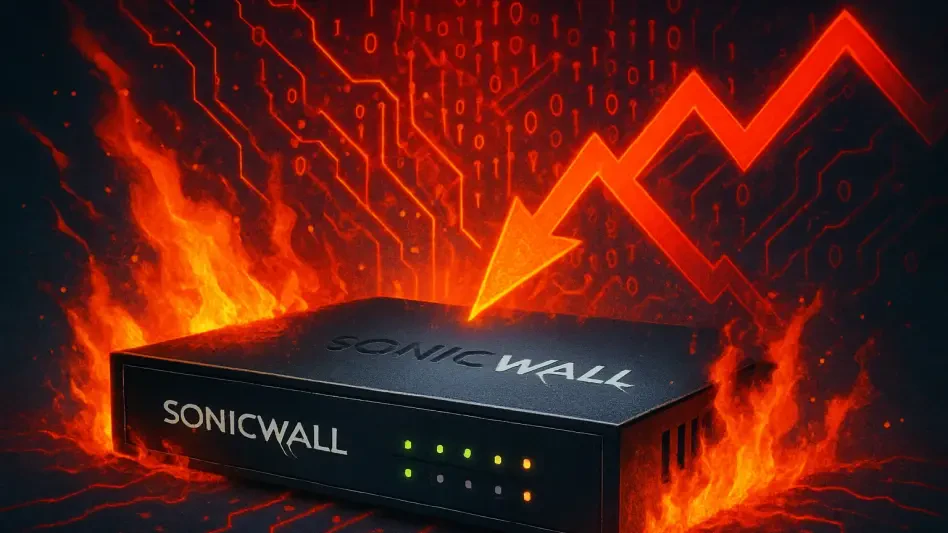In an era where cyber threats loom larger than ever, a staggering wave of attacks targeting SonicWall firewalls has sent shockwaves through the cybersecurity community, exposing critical weaknesses in devices meant to safeguard organizational networks. Firewall security stands as a cornerstone of digital defense, acting as the first line of protection against malicious intrusions. Yet, the recent mass exploitation of SonicWall Gen 7 firewalls underscores a troubling reality: even trusted solutions can become gateways for sophisticated threat actors. This analysis delves into the ongoing crisis, traces historical vulnerability patterns, incorporates expert perspectives, explores future implications, and provides actionable insights for organizations grappling with these escalating risks.
The Current Crisis: Mass Exploitation of SonicWall Gen 7 Firewalls
Scale and Impact of the Ongoing Attacks
Since mid-year, a dramatic surge in cyberattacks targeting SonicWall Gen 7 firewalls has been observed, with security firms like Huntress reporting around 20 distinct incidents in a short span. These attacks, escalating in frequency, often result in ransomware deployment within mere hours of initial compromise, highlighting the alarming speed of exploitation. The SSLVPN functionality, a critical feature for secure remote access, has emerged as the primary attack vector, drawing attention from multiple threat intelligence sources.
Reports from reputable organizations such as Arctic Wolf, Google, Huntress, and Mandiant Consulting confirm the widespread nature of this campaign. The focus on Gen 7 models, which are among the latest in SonicWall’s product lineup, suggests that even newer technologies are not immune to sophisticated threats. This broad-scale targeting raises serious concerns about the potential for widespread network breaches across industries relying on these devices for protection.
The rapid pace of these incidents amplifies the urgency for immediate response. Unlike slower, stealthier attacks, the current wave prioritizes speed, often catching organizations off-guard before defensive measures can be enacted. This trend of swift compromise points to a possible underlying flaw that threat actors are exploiting with precision and efficiency.
Real-World Consequences and Attack Patterns
The consequences of these exploits are dire, with the deployment of Akira ransomware being a prominent outcome. According to data from the Cybersecurity and Infrastructure Security Agency (CISA), Akira has impacted over 250 organizations, leading to extortion payments totaling approximately $42 million. Such financial devastation illustrates the high stakes involved when firewall defenses are breached.
Attack patterns reveal a calculated approach by adversaries, who frequently bypass multi-factor authentication to gain unauthorized access. Once inside, they exploit privileged accounts, install persistent backdoors, and disable security tools to ensure uninterrupted operations. These tactics create a pathway for ransomware encryption, often leaving victims with little recourse but to face significant downtime or pay hefty ransoms.
Beyond initial intrusion, the sophistication of post-compromise activities stands out. Attackers blend automated scripts with manual interventions to navigate internal networks, targeting critical systems like domain controllers. This combination of techniques not only maximizes damage but also complicates efforts to detect and mitigate the threat in real time, underscoring the need for robust preventive strategies.
Expert Insights on SonicWall Vulnerabilities
Perspectives from Industry Leaders
Charles Carmakal, CTO at Mandiant Consulting, has emphasized the unprecedented speed of these attacks, suggesting that a zero-day exploit—a flaw unknown to the vendor or public—might be at play. His analysis points to the financial motivations driving these campaigns, with threat actors prioritizing rapid gains over prolonged stealth. Such insights highlight the urgency for organizations to act decisively in the face of potential unpatched vulnerabilities.
Security experts across the board agree on the heightened risk posed by SSLVPN services in SonicWall firewalls. This consensus has led to the drastic recommendation from both industry professionals and SonicWall to disable this functionality temporarily. While this measure disrupts normal operations for many businesses, it reflects the gravity of the threat and the need to prioritize security over convenience.
Challenges in Response and Attribution
Further complicating the situation is the variability in attack techniques, as noted by Huntress researchers. The diversity in methods suggests either the involvement of multiple threat groups or a single actor adapting strategies to evade detection. This inconsistency poses significant challenges for defenders attempting to develop a unified response to the ongoing campaign.
The complexity of attributing these attacks adds another layer of difficulty. Without clear identification of the perpetrators, crafting targeted countermeasures becomes a daunting task. Experts stress that understanding the full scope of attacker methodologies is essential for building effective defenses against future iterations of these threats.
Historical Context and Future Implications of SonicWall Risks
A Legacy of Vulnerabilities
SonicWall’s history reveals a troubling pattern of security flaws, with 14 entries in CISA’s Known Exploited Vulnerabilities catalog over recent years. Many of these issues are tied to SSLVPN components across various product lines, including the SMA 100 series. This recurring theme of exploitation indicates systemic challenges in securing remote access functionalities, a critical aspect of modern network infrastructure.
The current focus on Gen 7 firewalls, despite their advanced design, mirrors past incidents but with heightened sophistication. Unlike earlier attacks on older, patched devices, this wave targets cutting-edge models, suggesting that threat actors are evolving alongside technology. Such persistence underscores the importance of addressing root causes rather than relying solely on reactive patches.
Looking Ahead: Opportunities and Challenges
SonicWall has committed to releasing updated firmware should a new vulnerability be confirmed, signaling a proactive stance toward resolution. This promise offers hope for strengthened security measures, potentially restoring trust among users. However, the timeline for such updates remains uncertain, leaving organizations in a precarious position as threats continue to mount.
Disabling SSLVPN, while a necessary stopgap, introduces operational disruptions for businesses dependent on remote connectivity. Balancing security with functionality will be a key challenge moving forward, requiring innovative solutions to maintain access without compromising safety. Organizations must prepare for these trade-offs as part of their risk management strategies.
On a broader scale, the persistent targeting by sophisticated actors suggests that SonicWall firewalls will remain in the crosshairs of cybercriminals. This reality necessitates a shift toward more resilient architectures and continuous monitoring to stay ahead of evolving tactics. The cybersecurity community must collaborate to anticipate and counteract these risks before they escalate further.
Key Takeaways and Call to Action
Reflecting on this critical trend, the active exploitation of SonicWall Gen 7 firewalls emerged as a defining cybersecurity challenge, driven by a suspected zero-day flaw in SSLVPN services. Historical patterns of vulnerabilities revealed a persistent weakness in SonicWall’s offerings, while expert analyses underscored the speed and financial intent behind the attacks. The real-world impact, exemplified by Akira ransomware’s devastating reach, painted a stark picture of the consequences when defenses faltered.
Looking back, the urgency to address firewall security stood out as a pivotal lesson, reinforcing its role as a bedrock of organizational protection. Moving forward, organizations are encouraged to adopt temporary mitigations, such as disabling vulnerable services, while closely monitoring SonicWall’s guidance for permanent fixes. Proactively enhancing network defenses through layered security approaches and staying vigilant against emerging threats have become essential steps to navigate the evolving landscape of cyber risks.








